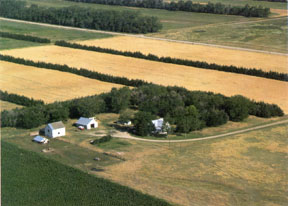 HOTO: J. BRANDLE, UNL
HOTO: J. BRANDLE, UNL
What is it?
Windbreaks are linear plantings of trees and shrubs designed to enhance crop production, protect people and livestock, and benefit soil and water conservation. Windbreaks can provide valuable opportunities for vine and tree fruit growers, row crop farmers, livestock producers, and rural homeowners.
Benefits
Boost crop yield and quality
Crop yield and quality. By microclimate modification, field and orchard windbreaks have been shown to increase the yield of many different crops. Windbreak protection can be especially valuable in orchards and vineyards of high-value horticultural crops.
IPM (Integrated Pest Management.) By incorporating plants that attract beneficial insects, windbreaks can also serve to increase biological control of crop insect pests.
Add specialty crops
Non-timber products. By using trees and shrubs that produce specialty food or decorative products, e.g. chokecherry or corkscrew willow, windbreaks can provide extra income.
Improve animal survival and weight gain
Animal survival. Tree-sheltered havens, or living barns, within pastures can make the difference between death and survival for livestock subject to harsh weather conditions, e.g. newborn and newly-shorn sheep.
Livestock performance. Windbreaks around feedlots have been shown to improve the health and weight gain of cattle and sheep in cold climates.
Produce timber from windbreaks
Timberbelts. Multirow windbreaks of fast-growing species such as poplar can be sequentially thinned for timber products while maintaining continuity of shelter.
Control wind erosion
Soil and water conservation. Windbreaks are proven effective in reducing wind erosion of light-textured soils. By dispersing snow evenly across fields, windbreaks help make more moisture available for crops.
Manage snow dispersal
Snow control. Properly placed windbreaks prevent snow buildup around buildings and on roadways.
Reduce energy costs and improve comfort
Energy conservation. Rural homes protected by windbreaks need 10-20% less energy for heating and cooling compared to unsheltered homes.
Human comfort. Windbreaks around farm dwellings and rural communities improve quality of life for the inhabitants by reducing wind speed along with noise and dust. Established windbreaks increase property values and enhance aesthetic benefits.
Wildlife habitat
Wildlife. Trees and shrubs provide much-needed food and habitat for game birds and other wildlife.
Carbon credits
Carbon sink. It has been estimated that for each acre planted in field windbreaks, over 21 metric tons of carbon dioxide will be stored in the trees by age 20.
Sources of information about windbreaks:
University of Nebraska, Lincoln: http://ianrpubs.unl.edu/Forestry/index.htm
USDA Natural Resources Conservation Service: www.nhq.nrcs.usda.gov/CCS/Buffers.html
Agriculture and Agri-Food Canada Agroforestry Development Centre: www.agr.gc.ca/agroforestry